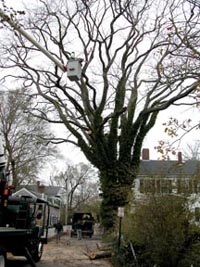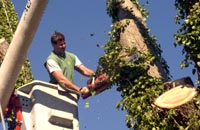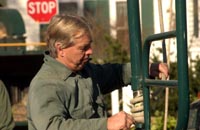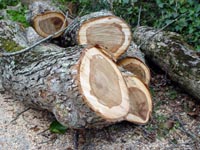From the sky down, goodbye to a grand old friend.
A towering ancient American elm tree on Davis Lane in Edgartown - believed to be one of the oldest and largest planted trees on the Vineyard - came down this week. Like so many of the stately elms that have graced the Vineyard since the 1800s, the tree succumbed to Dutch elm disease. Its majestic canopy stretched more than halfway from School street to Summer street, but in recent years the tree had lost its ability to leaf.

Located on town property, adjacent to the property of the Gazette, its massive trunk bound with ivy, the tree has been cared for by a variety of tree specialists over the years, chief among them Robert Hagerty, who owns Hagerty Tree Service. A seasoned local tree man, Bobby Hagerty, or Hag, as he is sometimes known, grew up in Vineyard Haven and remembers playing under the Davis Lane elm as a child.
This summer when the tree did not leaf out, Edgartown tree warden Stuart Fuller commissioned an expert arborist from Boston to examine it. After analysis of a bark sample, the prognosis from David C. Hawkins of Urban Forestry Solutions was unambiguous: The tree was dead and must be removed.
On Monday morning the work began.

Mr. Hagerty arrived with a crew of three, a collection of chain saws, ropes and pulleys and a cherry picker truck. For the next two days Mr. Hagerty, Chris Demers, Chris Morley and Daniel Devaney went about their business with the precision of engineers, the grit of woodsmen and the respect of poets.
Carried by a bark beetle that originated in Holland, Dutch elm disease is a fungus that invades the vascular system of a tree. The tree responds to the invasion by producing a toxic substance to stop the advance of the fungus. But the toxins eventually build up and block the transport of water and nutrients. Over time, the tree dies.
Treatments have been developed over the years, but there is no sure cure, and the spread of the fungus has killed many of the older trees in the last two decades. Other stresses can contribute, and Mr. Hagerty said he believes the real stress on the Davis Lane elm began with Hurricane Bob in 1991.
"Hurricane Bob and then the drought. That's what did this tree in," he said, recalling that he removed a large center section from the top of the tree after the hurricane.

Early Monday. Chris Demers went up in the bucket to begin removing the canopy. Up against a gray November sky, he worked the ropes and the chain saw with a sure hand. Piece by piece, step by step, the large old branches came off. Down below, Mr. Hagerty worked the ropes on the ground. Mr. Morley and Mr. Devaney gathered up the logs and branches as they fell and began feeding them into a chipper. The teamwork had an easy quality to it, punctuated by bits of conversation.
The talk was all about the upcoming Island Cup football game. The weather forecast (Mr. Hagerty hoped it would be good). The football forecast (Mr. Hagerty predicted a win for the Vineyard).
The day wore on. The crew kept at it, barely taking a break for lunch. The sound of the chain saw punctuated the quiet in downtown Edgartown. A thick layer of sawdust and chips began to carpet the lane that the old tree had shaded for a century and a half, and the adjacent lawn.
Throughout the day passersby stopped at each end of the blocked-off lane to watch. Most openly mourned the loss of the tree.
Mid-afternoon, Monday. Mr. Hagerty squinted up at the top. "There's no end to this tree," he declared.

"How are you going to cut through the bottom?" one onlooker asked.
"Don't know," the tree man replied.
Monday, dusk. The canopy was gone. Suddenly on Davis Lane there was a hole in the sky.
Elms have a rich history on the Vineyard. According to a 1957 account in the Gazette, the first recorded elms were planted in 1812 on lower Main street in Edgartown by Thomas Norton, who was the father of whaling captains James and Thomas Adams Norton. Among other places, elms were planted on North Water street and, according to lore, the luxuriant growth of an elm that grew in front of the home of Judge Joseph Thaxter Pease was traced to the fact that Mrs. Pease fed it faithfully with her dish water.
By 1971 many of the elms on the Vineyard had been lost to Dutch elm disease. "If no longer the elm, then what?" mused the late Henry Beetle Hough in a Gazette editorial.

The precise age of the Davis Lane elm is not known, but files at the Gazette help to date it somewhere between 1836 and 1857. According to the 1957 story, the elm that was planted in the yard of the former David Davis Academy was featured in a tree-planting ceremony conducted by Preceptor Davis, "with proper exhortation before an eager-eyed group of scholars."
On Tuesday morning a brilliant sun came up over the Edgartown harbor, illuminating the shorn top of the old elm like some giant museum sculpture. The Hagerty crew was back at work, with Mr. Demers still up in the bucket, using a bigger chain saw now to tackle the larger top limbs.
Mr. Fuller was on the scene, along with a small crew from the Edgartown highway department. A front-end loader and dump truck were deployed to clean up the good-sized logs that now rained down from above.

At midday Mr. Demers made a cut with the chain saw and the tree released a large gush of liquid. "It's bleeding - no, it's crying. Those are tears, maybe," Mr. Fuller mused.
Somewhere down the street church bells rang.
An inventory of town trees in Edgartown prepared by arborist Leighton T. Allenby three years ago listed the Davis Lane elm as one of the tallest trees in town, at 85 feet with a 65-foot canopy and a 48-inch trunk.
Mr. Hagerty estimated the height at 100 feet, the canopy even larger. But he did agree with the health assessment done for the town that year, which listed the tree in poor condition.
The tree man was respectful but pragmatic. "I'm not going to speculate about the cause - the tree is dead. We've been taking care of it for the last 30 years and now we're the people who are taking it down," he said simply.
Mid-afternoon on Tuesday. The old elm had been reduced to about ten feet in height, but still there was the daunting task of knocking over the massive trunk. The job was engineered using a long rope that was wrapped around three different points, including another tree in the yard and a Hagerty truck parked on the lane. A notch and a back-cut were made in what remained of the old elm. Highway department foreman Charlie Smith moved in with the loader truck. The truck strained and heaved for many long minutes, and finally the center section of the tree went over.

Mr. Smith climbed out and came over to have a look. "Stubborn thing, didn't want to go," he said.
Mr. Devaney nodded slowly. "It was just making its last stand," he said.
Mr. Fuller had a question for Mr. Hagerty. "Biggest tree you ever cut?" he said. "Top ten," the tree man replied.
Dusk fell and one large section of trunk was left. "End of the day," Mr. Hagerty said. "The last cut."
The crew was down to the last fresh chain for the three-foot saw, and this time it was Mr. Morley's turn. Handling the huge saw with ease, he worked his way methodically around the bottom of the stump, completely absorbed in the work, a Tootsie Roll pop stuck in his cheek. Mr. Demers climbed into the loader truck and wheeled it into position.
Then the last of the old elm went over, leaving only the flat table of the stump just above ground level. Mr. Hagerty used a small saw to trim ragged edges, leaving the stump table smooth.
Darkness began to close in. Mr. Devaney pointed at the freshly cut trunk, tipped on its back. "The real story is what lies between those ears," he said. "It's the story of a dying elm."






Comments (1)
Comments
Comment policy »